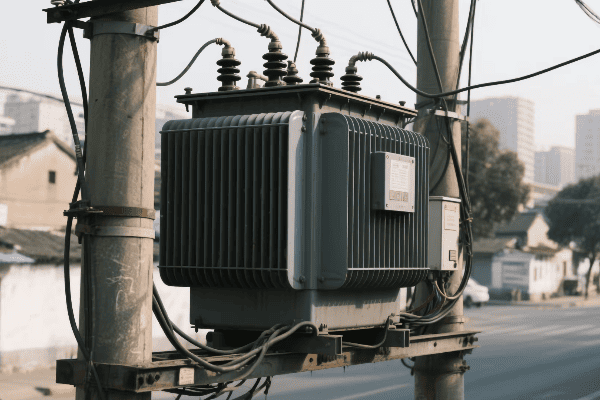Distribution Transformer Market: Trends Shaping the Future of Power Grid Efficiency?
Are you ready for the power revolution? The distribution transformer market is undergoing a seismic shift, and it’s reshaping our energy landscape in ways we never imagined.
The distribution transformer market is evolving rapidly, driven by technological innovations, smart grid integration, and the push for energy efficiency. These trends are not just improving grid performance; they’re redefining how we generate, distribute, and consume electricity in the 21st century.

As someone who’s been in the power industry for years, I’ve witnessed firsthand the incredible changes sweeping through the distribution transformer market. Let’s dive into the trends that are shaping the future of power grid efficiency and explore what they mean for our energy future.
Technological Innovations: Revolutionizing Distribution Transformer Efficiency?
Have you ever wondered how transformers keep getting smaller yet more powerful? The answer lies in cutting-edge technological innovations that are pushing the boundaries of efficiency.
Technological innovations in distribution transformers include advanced core materials, smart monitoring systems, and improved cooling technologies. These advancements significantly reduce energy losses, extend transformer lifespan, and enable real-time performance optimization.

Let’s explore the key innovations revolutionizing transformer efficiency:
Advanced Core Materials
Pushing the limits of energy conservation:
- Amorphous metal cores reducing no-load losses by up to 70%
- Grain-oriented electrical steel with lower hysteresis losses
- Nanocrystalline materials offering superior magnetic properties
Smart Monitoring Systems
Real-time insights for optimal performance:
- IoT-enabled sensors for continuous health monitoring
- AI-driven analytics for predictive maintenance
- Cloud-based platforms for remote management and control
Improved Cooling Technologies
Keeping transformers cool under pressure:
- Ester-based cooling fluids for better heat dissipation
- Phase-change materials for passive cooling
- Advanced radiator designs for enhanced natural cooling
| Innovation | Efficiency Impact | Market Trend |
|---|---|---|
| Amorphous Cores | 70% reduction in core losses | Rapid adoption in urban grids |
| Smart Monitoring | 30% decrease in unexpected failures | Growing demand for IoT integration |
| Ester Cooling | 20% increase in overload capacity | Shift towards eco-friendly solutions |
I remember visiting a transformer manufacturing plant last year. The engineer showed me their latest amorphous core transformer. "This beauty," he said, "can save enough energy to power a small town compared to older models." It was a moment that truly brought home the impact of these innovations.
Another eye-opening experience was at a smart grid conference. A utility manager demonstrated their new AI-powered transformer monitoring system. "We used to react to failures," she explained. "Now, we prevent them before they happen." The potential for improved reliability and reduced downtime was clear.
These technological innovations are not just incremental improvements; they’re game-changers in the distribution transformer market. They’re enabling utilities to do more with less, significantly reducing energy losses and operational costs. As we continue to push the boundaries of materials science and digital technology, I expect to see even more revolutionary advancements in transformer efficiency. The future of power distribution is not just about moving electricity; it’s about moving it with unprecedented efficiency and intelligence.
Smart Grid Integration: Transforming Demand Patterns in the Distribution Transformer Market?
Ever wondered how our power grids are getting smarter? The integration of distribution transformers with smart grid technology is revolutionizing how we manage and distribute electricity.
Smart grid integration in the distribution transformer market enables real-time load management, bidirectional power flow, and advanced grid analytics. This integration is transforming demand patterns, improving grid reliability, and paving the way for more efficient and responsive power distribution systems.

Let’s explore how smart grid integration is reshaping the transformer market:
Real-Time Load Management
Balancing power supply and demand:
- Dynamic load balancing across the grid
- Automated voltage regulation for optimal power quality
- Demand response capabilities for peak load management
Bidirectional Power Flow
Enabling the prosumer revolution:
- Support for distributed energy resources (DERs)
- Integration of residential solar and energy storage systems
- Enhanced grid stability with two-way power flow management
Advanced Grid Analytics
Data-driven decision making:
- Big data analytics for predictive grid management
- Machine learning algorithms for optimized transformer deployment
- Improved asset management and maintenance scheduling
| Smart Grid Feature | Impact on Transformers | Market Trend |
|---|---|---|
| Real-Time Management | Increased operational efficiency | Growing demand for smart transformers |
| Bidirectional Flow | Need for more flexible designs | Rise in transformer upgrades |
| Advanced Analytics | Improved lifecycle management | Increased investment in data infrastructure |
I recently visited a utility company that had just implemented a smart grid system. The grid operator showed me their control room, filled with screens displaying real-time data from thousands of transformers. "We can now see and manage our entire grid like never before," he said. "It’s like having X-ray vision for our power system."
Another fascinating experience was at a residential microgrid project. The community had installed smart transformers that could seamlessly integrate rooftop solar and electric vehicle charging. A homeowner told me, "Our transformer doesn’t just deliver power; it helps us generate and store our own energy too."
These experiences highlight how smart grid integration is fundamentally changing the role of distribution transformers. They’re no longer passive components but active, intelligent nodes in a dynamic energy network. This shift is driving demand for more advanced transformer technologies and creating new opportunities in the market.
As smart grid adoption continues to grow, I expect to see a surge in demand for transformers with built-in communication and control capabilities. The future of the distribution transformer market will be shaped by how well manufacturers can meet these evolving needs, blending traditional power engineering with cutting-edge digital technology.
Energy Efficiency Standards: Driving Market Evolution and Product Development?
Are you aware of how energy efficiency standards are reshaping the distribution transformer market? These regulations are not just guidelines; they’re catalysts for innovation and market transformation.
Energy efficiency standards in the distribution transformer market are driving the development of high-performance products and influencing market dynamics. These standards are pushing manufacturers to innovate, leading to transformers with lower losses, longer lifespans, and improved overall efficiency.

Let’s delve into how these standards are evolving the market:
Global Efficiency Regulations
Raising the bar worldwide:
- DOE efficiency standards in the United States
- EU Ecodesign requirements for transformers
- China’s energy efficiency tiers for distribution transformers
Total Ownership Cost (TOC) Approach
Shifting focus from initial cost to lifetime value:
- Consideration of both purchase price and operational costs
- Emphasis on long-term energy savings
- Incentives for investing in high-efficiency models
Performance Testing and Certification
Ensuring compliance and performance:
- Standardized testing procedures for transformer efficiency
- Third-party certification programs
- Regular updates to testing methods to reflect technological advancements
| Efficiency Standard | Market Impact | Product Development Trend |
|---|---|---|
| DOE Levels | Phasing out of low-efficiency models | Focus on amorphous core technology |
| EU Ecodesign | Increased demand for premium efficiency | Development of ultra-low loss designs |
| China’s Tiers | Market segmentation based on efficiency | Innovation in cooling and insulation |
I remember attending an industry conference where a panel of experts discussed the impact of new efficiency standards. One manufacturer shared, "When the standards first came out, we thought they were impossible to meet. Now, we’re exceeding them and seeing huge demand for our high-efficiency models."
Another enlightening experience was visiting a utility that had recently upgraded their transformer fleet to meet new standards. The energy savings were substantial. The operations manager told me, "Our new transformers are so efficient, it’s like we’ve added a small power plant to our grid without building anything new."
These standards are not just regulatory hurdles; they’re driving forces for innovation in the distribution transformer market. They’re pushing manufacturers to invest in R&D, develop new materials and designs, and rethink their entire approach to transformer production.
As efficiency standards continue to evolve, I anticipate seeing even more groundbreaking developments in transformer technology. The market is likely to shift further towards high-efficiency models, with a growing emphasis on lifecycle costs rather than just upfront pricing. This trend will not only benefit utilities and end-users through reduced energy losses but also contribute significantly to global efforts in energy conservation and sustainability.
Renewable Energy Adaptation: Reshaping Distribution Transformer Designs for Sustainable Power?
Have you noticed how the rise of renewable energy is changing our power grids? This shift is having a profound impact on distribution transformer designs, pushing them to adapt to a new era of sustainable power.
The integration of renewable energy sources is reshaping distribution transformer designs to handle bidirectional power flow, voltage fluctuations, and intermittent generation. These adaptations are crucial for supporting the growth of solar, wind, and other clean energy technologies in our power grids.

Let’s explore how transformers are evolving to support renewable energy:
Bidirectional Power Flow Management
Enabling energy prosumers:
- Designs that support reverse power flow from distributed generation
- Enhanced protection systems for backfeed scenarios
- Smart inverter integration for improved grid stability
Voltage Regulation Capabilities
Handling fluctuations from renewable sources:
- On-load tap changers for dynamic voltage adjustment
- Reactive power compensation features
- Advanced control algorithms for voltage stability
Harmonic Mitigation
Addressing power quality issues:
- Enhanced core designs to withstand harmonic currents
- Integration of active harmonic filters
- Improved insulation systems for higher frequency stresses
| Renewable Adaptation | Design Change | Grid Benefit |
|---|---|---|
| Bidirectional Flow | Reversible windings | Supports distributed generation |
| Voltage Regulation | Advanced tap changers | Improves power quality |
| Harmonic Mitigation | Specialized core materials | Enhances grid stability |
I recently visited a solar farm where they had installed specially designed transformers to handle the variable output. The site manager explained, "These transformers don’t just step up voltage; they act like conductors, orchestrating the flow of power between the solar panels and the grid."
Another eye-opening experience was at a wind farm that used transformers with advanced voltage regulation. During gusty conditions, I watched as the transformers seamlessly adjusted to maintain stable grid voltage. An engineer remarked, "Without these smart transformers, integrating wind power would be a nightmare for grid stability."
These experiences highlight how renewable energy is driving innovation in transformer design. It’s not just about handling power; it’s about intelligently managing the complex interplay between variable generation sources and the grid.
As renewable energy continues to grow, I expect to see even more specialized transformer designs emerging. We might see transformers with built-in energy storage capabilities or designs that can rapidly switch between different operational modes to support grid flexibility. The future of distribution transformers in a renewable-heavy grid is not just about power transformation; it’s about active participation in a dynamic, sustainable energy ecosystem.
Urbanization and Infrastructure: Fueling Growth and Innovation in Transformer Technologies?
Ever wondered how our growing cities are changing the power game? Urbanization and infrastructure development are major drivers in the distribution transformer market, sparking a wave of innovations.
Rapid urbanization and infrastructure expansion are fueling growth and innovation in transformer technologies. The demand for compact, high-capacity, and smart transformers is rising, driving the development of urban-friendly designs that can meet the complex power needs of modern cities.

Let’s dive into how urban growth is shaping transformer technologies:
Compact and High-Capacity Designs
Maximizing power in limited spaces:
- Dry-type transformers for indoor installations
- Gas-insulated transformers for reduced footprint
- High-power density designs for urban substations
Urban-Specific Features
Addressing unique city challenges:
- Low-noise designs for residential areas
- Fire-resistant technologies for high-rise buildings
- Underground transformer solutions for space-constrained areas
Smart City Integration
Powering the cities of tomorrow:
- IoT-enabled transformers for smart grid compatibility
- Support for electric vehicle charging infrastructure
- Integration with urban energy management systems
| Urban Trend | Transformer Innovation | Market Impact |
|---|---|---|
| Space Constraints | Compact Designs | Increased demand for smaller, powerful units |
| Noise Regulations | Low-Noise Technology | Growing market for silent transformers |
| Smart City Initiatives | IoT Integration | Rise in smart transformer deployments |
I recently toured a new urban development where they were installing compact substations right in the basement of high-rise buildings. The project manager told me, "These transformers pack the power of a traditional substation into the size of a large closet. It’s a game-changer for urban power distribution."
Another fascinating experience was in a smart city pilot project. They had deployed IoT-enabled transformers throughout the downtown area. A city planner explained, "These transformers don’t just distribute power; they’re the nervous system of our smart grid, constantly communicating and adjusting to optimize energy use across the city."
These experiences underscore how urbanization is driving innovation in transformer technologies. It’s not just about making transformers smaller or more powerful; it’s about reimagining their role in the urban environment.
As cities continue to grow and evolve, I anticipate seeing even more specialized transformer solutions emerging. We might see transformers that can be easily upgraded or reconfigured to meet changing urban needs, or designs that integrate seamlessly with urban architecture. The future of transformer technology in cities is about blending in while standing out in performance – providing the lifeblood of urban power while adapting to the unique challenges of city life.
Conclusion
The distribution transformer market is evolving rapidly, driven by technological innovations, smart grid integration, efficiency standards, renewable energy adaptation, and urbanization. These trends are shaping a more efficient, sustainable, and intelligent power grid for the future.
Free CHBEB Transformer Catalog Download
Get the full range of CHBEB transformers in one catalog.
Includes oil-immersed, dry-type, pad-mounted, and custom solutions.
Quick Message
Request A free quote
We'd like to work with you
- +86 15558785111
- [email protected]
- +86 15558785111
What We Do
CHINA BEI ER BIAN (CHBEB) GROUP, with 218 million in registered capital, originated from Beijing Beierbian Transformer Group. Headquartered in Beijing for R&D, it operates major production bases in Nanjing and Yueqing, producing high-quality products.
Latest Product
address
BeiJing
No 3,RongJing East Road,BeiJing Economic Technological Development Area,BeiJing,China
JiangSu
No 7️Xiangfeng Road,Jiangning,NanJing,JiangSu,China
WenZhou
No.211, Wei 16 Road, Industrial Zone, Yueqing, Wenzhou, Zhejiang, China.
XiangYang Industrial Zone ,YueQing,WenZhou,ZheJiang,China
contact us
- [email protected]
- +86 13057780111
- +86 13057780111
- +86 15558785111
Copyright © Bei Er Bian Group


